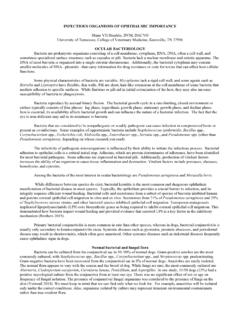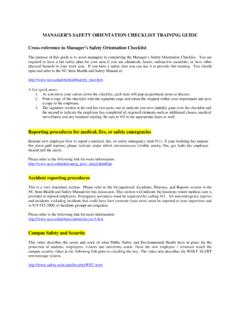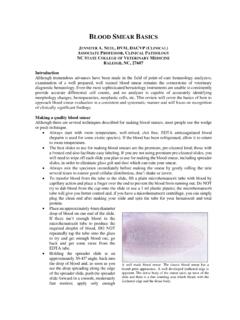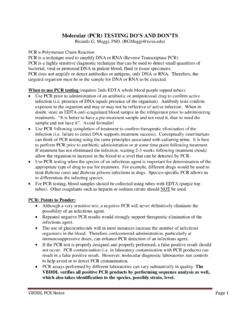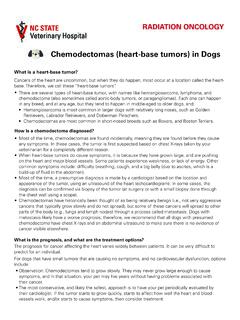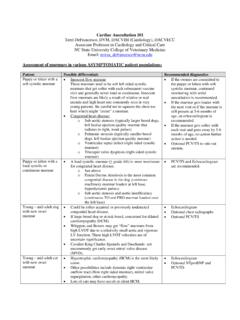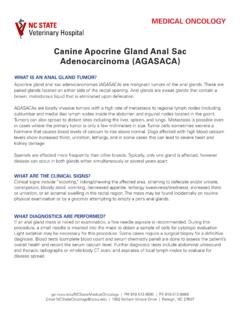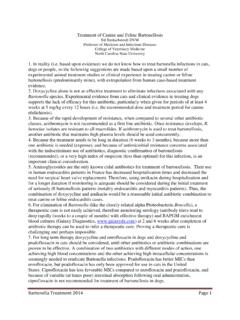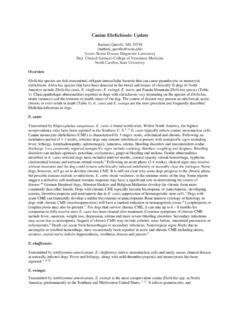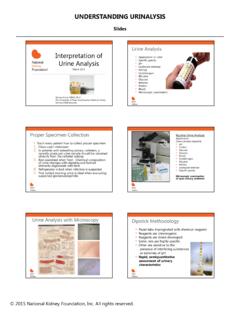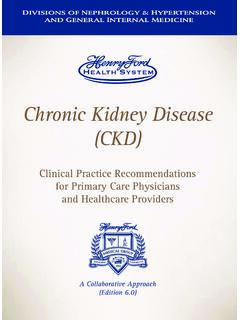Transcription of STANDARD OF CARE FOR PROTEINURIA
1 STANDARD OF CARE FOR PROTEINURIA Shelly L. Vaden, North Carolina State University CVM, Raleigh, NC PROTEINURIA is a negative prognostic indicator for both dogs and cats with chronic kidney disease. In dogs with chronic kidney disease, an initial urine protein: creatinine ratio (UPC) of > was associated with a threefold greater risk of developing a uremic crisis and death. The relative risk of adverse outcomes increased times for every increase in the UPC by 1. In another canine study, PROTEINURIA correlated with the degree of functional impairment, as measured by glomerular filtration rate; dogs with UPC of < lived times longer on average than dogs with a UPC > When nonazotemic cats were prospectively and longitudinally evaluated, PROTEINURIA was found to be significantly associated with the development of azotemia by 12 months.
2 Both PROTEINURIA and serum creatinine were related to shortened survival in cats with chronic kidney disease. This was true even when cats had UPC as low as Chronic PROTEINURIA has been shown to lead to interstitial fibrosis as well as tubular degeneration and atrophy. There is some evidence that reabsorbed proteins and lipids are directly toxic to the tubular epithelial cells, triggering inflammation and apoptosis. In addition, excessive lysosomal processing of proteins leads to lysosomal rupture and the intracellular release of cytotoxic enzymes. PROTEINURIA may increase the workload of the tubular epithelial cell beyond its capabilities.
3 Proteinacious casts cause tubular obstruction, which further injures the cells. Glomerular injury results decreased perfusion of the tubulointerstitium, resulting in cellular hypoxia. Increased glomerular permselectivity increases the filtration of other substances, such as transferrin, that cause additional tubular injury. Because PROTEINURIA is associated with negative outcomes, it is imperative that the practice veterinarian has a thorough understanding of appropriate management of PROTEINURIA in dogs and cats with chronic kidney disease. The purpose of this presentation is to discuss the STANDARD of care for dogs and cats with PROTEINURIA .
4 Clinical Assessment of PROTEINURIA Accurate assessment of PROTEINURIA involves 3 key elements: persistence, localization, and magnitude. Persistent PROTEINURIA is defined as PROTEINURIA that has been detected on 3 or more occasions, 2 or more weeks apart. Identifying the cause of PROTEINURIA in an affected dog or cat is important so that appropriate therapeutic measures can be implemented. Pre-renal PROTEINURIA occurs when there is greater than normal delivery of low molecular weight plasma proteins to the normal glomerulus (ex: hemoglobinuria, myoglobinuria). Post-renal PROTEINURIA occurs when there is entry of protein into the urine in association with exudation of blood or serum into the lower urinary or genital tracts (ex: urinary tract infection, urolithiasis, neoplasia).
5 It is important to ensure that PROTEINURIA is not due to pre-renal or post-renal causes because the management of these disorders varies substantially from the management of chronic kidney disease. Renal PROTEINURIA that is glomerular or tubulointerstitial in origin is the most relevant form of PROTEINURIA when managing dogs with chronic kidney disease. Functional PROTEINURIA is not very common in dogs and cats, or at least poorly documented. Once pre-renal and post-renal causes of persistent PROTEINURIA are eliminated, magnitude is used to help determine if renal PROTEINURIA is glomerular or tubulointerstitial in origin.
6 Magnitude is assessed using a quantitative test for urine protein (generally UPC but could also be urine albumin). Once pre-renal and post-renal causes of PROTEINURIA have been excluded, it is recommended that a UPC be evaluated in all dog with persistent PROTEINURIA as determined by dipstick or SSA. On the other hand, the target UPC for therapeutic intervention in cats might be as low as With this low magnitude of PROTEINURIA , a cat with chronic kidney disease and dilute urine might be negative for PROTEINURIA when measured by urine dipstick. For this reason, it is suggested that all cats with chronic kidney disease have a UPC measured once or twice yearly.
7 The International Renal Interest Society (IRIS) has recommended substaging dogs and cats with chronic kidney disease on the basis of their UPC (Table 1). Dogs that have renal PROTEINURIA and a UPC usually have glomerular disease, whereas dogs with UPC < might have either glomerular disease or tubulointerstitial disease. Glomerular diseases occur less commonly in cats but should be suspected when the UPC is 1. Concurrent hypoalbuminuria is added evidence that glomerular disease is present. Inhibition of RAAS to Manage PROTEINURIA Because hemodynamic forces influence the transglomerular movement of proteins, it follows that altering renal hemodynamics would be effective in reducing PROTEINURIA .
8 The renin-angiotensin-aldosterone system (RAAS) has been the major target system for this approach to reducing PROTEINURIA . Agents that target RAAS include the angiotensin converting enzyme inhibitors (ACEi), angiotensin receptor blockers (ARB), and aldosterone receptor antagonists (Table 2). All RAAS inhibitors have antihypertensive effects although most of them only minimally reduce blood pressure ( , 10-15%). These drugs likely reduce PROTEINURIA by several mechanisms in addition to the expected decrease in glomerular capillary hypertension. Likewise, the reduction in PROTEINURIA is greater than would be expected on the basis of their antihypertensive effects alone.
9 RAAS inhibition is considered a STANDARD of care in dogs and cats with renal PROTEINURIA where the UPC is > and > respectively. The inhibitors of RAAS reduce PROTEINURIA in populations of animals but the effect in individual animals might vary. It may take trial and error with different drugs or combinations of drugs before the target antiproteinuric effect is achieved; some animals may never achieve target reductions. The UPC, urinalysis, systemic blood pressure and serum albumin, creatinine and potassium concentrations (in fasting samples) should be monitored at least quarterly in all animals being treated for proteinuric renal disease.
10 However, those that are having new drugs introduced or dosage modifications being made for drugs already being administered should be monitored more frequently. One to 2 weeks after an ACEi or ARB is added or changed, the UPC, serum creatinine, serum potassium and systemic blood pressure should be evaluated to verify that the recent change in therapy has not resulted in a severe worsening of renal function ( , >30% increase in serum creatinine), a concerning increase in serum potassium concentrations, or hypotension (an unlikely occurrence with these drugs). Day-to-day variations in the UPC occur in most dogs with glomerular PROTEINURIA , with greater variation occurring in dogs with UPC >4.
